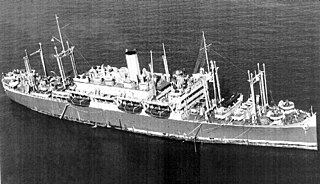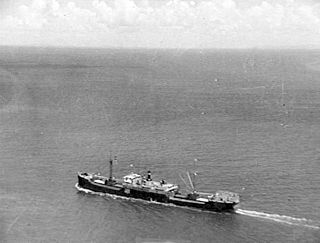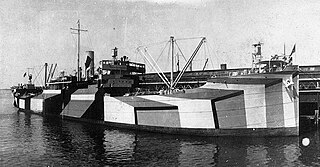USS Captor (PYc-40), briefly the seventh ship to bear the name USS Eagle (AM-132), was a Q-ship of the United States Navy.

USCGC Staten Island (WAGB-278) was a United States Coast Guard Wind-class icebreaker. Laid down on 9 June 1942 and launched on 28 December 1942, the ship was commissioned on 26 February 1944, and almost immediately afterward transferred to the Soviet Union, under the Lend Lease program, under the name Severny Veter, which loosely translates as Northwind, until 19 December 1951. When returned to the United States Navy, she was designated USS Northwind until 15 April 1952, when she was renamed Staten Island to distinguish her from her successor USCGC Northwind (WAGB-282) which had been laid down shortly after she was lent to the Soviet Union. The ship was transferred to the U.S. Coast Guard as USCGC Staten Island in February 1965, and served until November 1974, before being scrapped.

The TS Golden Bear is the training ship of the California State University Maritime Academy (CSUMA), a campus of the California State University. The first training ship of the then–California Nautical School was known as the Training Ship California State, then as the T.S. Golden State. Since then, there have been three ships to bear the name T.S. Golden Bear.

The Cherokee class of fleet tugboats, originally known as the Navajo class, were built for the United States Navy prior to the start of World War II. They represented a radical departure from previous ocean-going tug designs, and were far more capable of extended open ocean travel than their predecessors. This was due in large part to their length of 205 feet (62 m), 38 feet (12 m) beam, and substantial fuel-carrying capacity. They were also the first large surface vessels in the United States Navy to be equipped with Diesel-electric drive.

SS President Cleveland was originally built as Golden State for the United States Shipping Board (USSB), one of the planned World War I troop transports converted before construction into passenger and cargo vessels launched as Emergency Fleet Corporation Design 1029 ships first known, along with the smaller Design 1095 versions, in the trade as "State" ships due to names assigned for the nicknames of states and later as "535s" for their length overall. Almost all ships of both designs were renamed for United States presidents by May 1921, with Golden State being renamed President Cleveland. As one of the USSB-owned ships operated by agents of the board, President Cleveland was allocated to and operated by the Pacific Mail Steamship Company until sold by the USSB to the Dollar Steamship Line in 1925. After the demise of that line and creation of a new, replacement line, American President Lines, the ship remained with that line until government acquisition for the Second World War.

American Legion was built for the United States Shipping Board (USSB), one of the planned World War I troop transports converted before construction into passenger and cargo vessels, the Emergency Fleet Corporation Design 1029 ships. The ship was laid down as Koda and perhaps assigned the name Badger State at one point, but renamed American Legion before launch and one of only a few of the design not taking a state nickname. Originally operated by the USSB's agents and the Munson Steamship Line the ship saw commercial service until laid up 13 March 1939.

USS Henry T. Allen was a Harris class attack transport in service with the United States Army from 1940 to 1941. She was then transferred to the United States Navy where she served until 1946. She was scrapped in 1948. The ship was originally built as an Emergency Fleet Corporation Design 1029 ship in 1919 and operated in commercial service as Wenatchee and President Jefferson until being laid up in 1938.

SS Point Bonita was constructed in 1918 and launched 27 March 1918 after a hull being built for foreign owners at Albina Engine and Machine Works was requisitioned during World War I by the United States Shipping Board (USSB). The ship saw service as the Navy transport USS Point Bonita, assigned Identification Number 3496, from 7 October 1918 to 7 April 1919, was returned to the USSB and saw civilian service with several commercial companies as San Pedro and Oliver Olson before again seeing service in World War II as USS Camanga (AG-42). After return to commercial service as Oliver Olson the ship was wrecked at the entrance to Bandon harbor in Oregon.

USS Majaba (AG-43/IX-102) was the Design 1049 cargo ship Meriden built in 1919 by the Albina Engine & Machine Works, Portland, Oregon. All the ships were requisitioned by the United States Shipping Board (USSB) for World War I service. The ship was bought by the E. K. Wood Lumber Co., of San Francisco, California in 1923 and renamed El Capitan. The ship was chartered by the U.S. Navy through the War Shipping Administration (WSA) in April 1942 and commissioned as Majaba.

USS Tuluran (AG-46) was under construction for the British at the Toledo Shipbuilding Company as the cargo ship War Bayonet in 1917 when requisitioned by the United States Shipping Board (USSB) for World War I service. The ship was launched and completed as Lake Superior. The Navy acquired the ship from the USSB with assignment to the Naval Overseas Transport Service (NOTS) with the identification number ID-2995. The ship was returned to the USSB which sold the vessel in 1926. The ship was renamed C. D. Johnston III and that vessel operated out of Oregon until again sold and based in San Francisco. Another sale resulted in the vessel being renamed Anna Shafer which was acquired by the War Shipping Administration (WSA) in 1942 and allocated to the Navy for World War II service.

USS Besboro (AG-66) was built as Caddopeak, a United States Shipping Board (USSB) Emergency Fleet Corporation Design 1049 cargo ship built by Albina Engine & Machine Works, launched 18 October 1918. From 1922 Caddopeak served several commercial shipping companies until sold in 1937 to Burns Steamship Company and renamed Lurline Burns. On 2 February 1942 the ship was delivered to the War Shipping Administration, allocated to the United States Army and operated by Burns and Alaska Steamship Company under an Army charter agreement.

USS West Avenal (ID-3871) was a cargo ship in the United States Navy during World War I. She had been built as SS West Avenal for the United States Shipping Board (USSB) as part of the West boats, a series of steel-hulled cargo ships built on the West Coast of the United States. West Avenal was launched in October 1918 by the Western Pipe and Steel Company of San Francisco, California, and delivered to the US Navy when she was completed in February 1919. After she was commissioned and had taken on a load of flour, West Avenal sailed to Norfolk, Virginia, where she was decommissioned in early April.

MS West Honaker was a diesel-powered cargo ship of the United States Maritime Commission (USMC) that was part of the "Corncob Fleet" of old ships sunk as part of the "gooseberry" breakwater off Utah Beach during the Normandy invasion. The ship was originally built as SS West Honaker, a steam-powered cargo ship built for the United States Shipping Board (USSB), a predecessor of the USMC. At the time of her completion in 1920, the ship was inspected by the United States Navy for possible use as USS West Honaker (ID-4455) but was neither taken into the Navy nor ever commissioned under that name.

MS West Grama, sometimes spelled as West Gramma, was a diesel-powered cargo ship of the United States Maritime Commission (USMC) that was sunk as part of the "gooseberry" breakwater off Utah Beach during the Normandy invasion. Prior to her diesel conversion, she was known as SS West Grama. In 1919, she was briefly taken up by the United States Navy under the name USS West Grama (ID-3794).

West Compo was a steam cargo ship built in 1918–1919 by Northwest Steel Company of Portland for the United States Shipping Board as part of the wartime shipbuilding program of the Emergency Fleet Corporation (EFC) to restore the nation's Merchant Marine. The vessel was commissioned into the Naval Overseas Transportation Service (NOTS) of the United States Navy in January 1919 and after only one overseas trip was decommissioned four months later and returned to the USSB. Afterwards the vessel was largely employed on the Atlantic Coast of the United States to France route until mid-1921 when she was laid up and eventually broken up for scrap in 1936.
USS West Coast (ID-3315) was a cargo ship for the United States Navy during World War I. The ship was laid down as SS War Dagger but launched in July 1918 as SS West Coast and reverted to that name at the end of her Navy service.

SS West Loquassuck was a steel–hulled cargo ship built for the United States Shipping Board's Emergency Fleet Corporation in World War I. After completion on 15 October 1918, the ship was immediately commissioned into the U.S. Navy as USS West Loquassuck (ID-3638), just weeks before the end of the war.

SS West Mahomet was a steel–hulled cargo ship which saw service as an auxiliary with the U.S. Navy in 1918-19.

The Type B ship is a United States Maritime Administration (MARAD) designation for World War II barges. Barges are very low cost to build, operate and move. Barges were needed to move large bulky cargo. A tug boat, some classed as Type V ships, could move a barge, then depart and move on to the next task. That meant the barge did not have to be rushed to be unloaded or loaded. Toward the end of World War 2, some ships that had not been completed in time for the war were converted to barges. US Navy barges are given the prefix: YWN or YW. Due to shortage of steel during World War II, concrete ship constructors were given contracts to build concrete barges, with ferrocement and given the prefix YO, YOG, YOGN. Built in 1944 and 1945, some were named after elements.

The SS Harry Luckenbach, built as a cargo ship ordered by the Luckenbach Steamship Company and built at Sun Shipbuilding and Drydock Co. in Chester, Pennsylvania in 1919. The as yet unnamed ship was requisitioned by the United States Shipping Board (USSB) before completion and converted to a troop transport. The USSB allocated the ship, which had been fitted out with temporary troop accommodation in its cargo spaces, to the Navy which commissioned the ship on 7 July 1919 as USS Sol Navis with the Identification number 4031A. The ship was decommissioned October 1919 after two trips to France.
















